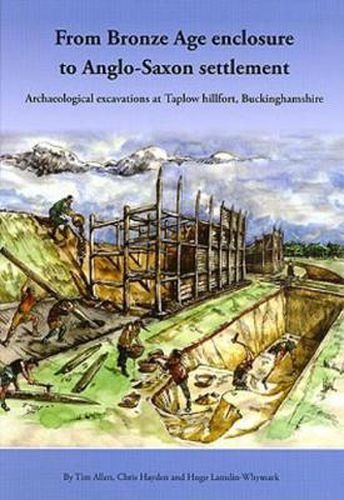Readings Newsletter
Become a Readings Member to make your shopping experience even easier.
Sign in or sign up for free!
You’re not far away from qualifying for FREE standard shipping within Australia
You’ve qualified for FREE standard shipping within Australia
The cart is loading…






Recent excavations at Taplow Court have revealed a long sequence of activity stretching from the Mesolithic to the Anglo-Saxon period. Mesolithic struck flints and charred hazelnuts, and early Neolithic flints, were found in a small number of tree-throw holes. A group of inter-cutting hollows or shallow pits of Early Bronze Age date included sherds of Collared Urn and worked flint, rare evidence of domestic activity of this period. There were also finds of the middle Bronze Age, although no features of that phase were confirmed. In the late Bronze Age, a defensible hilltop enclosure about 1.2 ha was constructed on the site. The enclosure, probably first established in the 11th century cal BC, had a complex sequence of defences including a pair of post-rows possibly indicating a timber palisade backed by a raised walkway, a trench-built palisade, a ditch and rampart and further posthole-lines outside the ditch. Only a limited area of the interior was examined, but includes a series of parallel fence lines, one probable roundhouse and up to five possible four-post structures, with occupation extending into the 9th century cal BC. Following a probable hiatus in activity represented by a standstill deposit in the upper part of the ditch, a larger U-profiled hillfort ditch was constructed in the Early Iron Age, probably in the 5th century cal BC, the spoil being dumped over the previous ditch to form a timber-laced rampart, which was soon after destroyed in places by fire. The remains of the charred timbers within the rampart have revealed some details of its construction. The ditch however remained open into the Saxon period, and another internal roundhouse may be Middle Iron Age. A third and even larger V-profiled ditch was found outside the second ditch. Although the date of construction of this outer ditch is uncertain, it too remained open into the Saxon period, suggesting that the hillfort had many ditches its later stages. Price is approximate.
$9.00 standard shipping within Australia
FREE standard shipping within Australia for orders over $100.00
Express & International shipping calculated at checkout
Recent excavations at Taplow Court have revealed a long sequence of activity stretching from the Mesolithic to the Anglo-Saxon period. Mesolithic struck flints and charred hazelnuts, and early Neolithic flints, were found in a small number of tree-throw holes. A group of inter-cutting hollows or shallow pits of Early Bronze Age date included sherds of Collared Urn and worked flint, rare evidence of domestic activity of this period. There were also finds of the middle Bronze Age, although no features of that phase were confirmed. In the late Bronze Age, a defensible hilltop enclosure about 1.2 ha was constructed on the site. The enclosure, probably first established in the 11th century cal BC, had a complex sequence of defences including a pair of post-rows possibly indicating a timber palisade backed by a raised walkway, a trench-built palisade, a ditch and rampart and further posthole-lines outside the ditch. Only a limited area of the interior was examined, but includes a series of parallel fence lines, one probable roundhouse and up to five possible four-post structures, with occupation extending into the 9th century cal BC. Following a probable hiatus in activity represented by a standstill deposit in the upper part of the ditch, a larger U-profiled hillfort ditch was constructed in the Early Iron Age, probably in the 5th century cal BC, the spoil being dumped over the previous ditch to form a timber-laced rampart, which was soon after destroyed in places by fire. The remains of the charred timbers within the rampart have revealed some details of its construction. The ditch however remained open into the Saxon period, and another internal roundhouse may be Middle Iron Age. A third and even larger V-profiled ditch was found outside the second ditch. Although the date of construction of this outer ditch is uncertain, it too remained open into the Saxon period, suggesting that the hillfort had many ditches its later stages. Price is approximate.